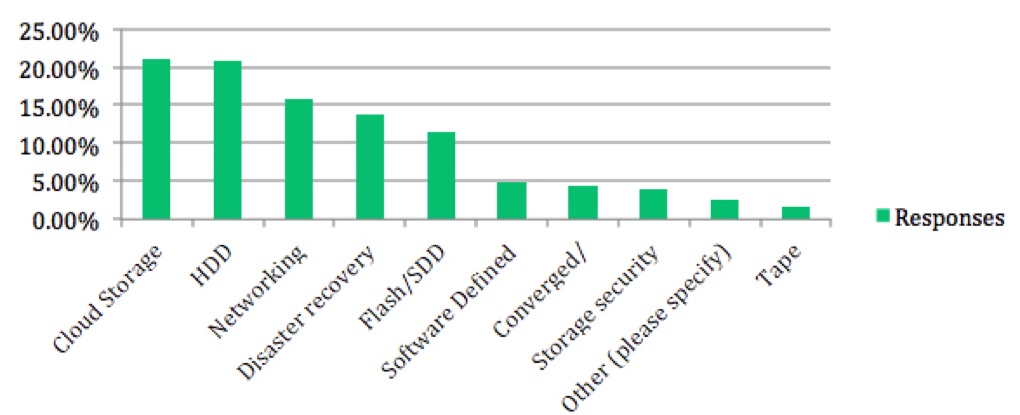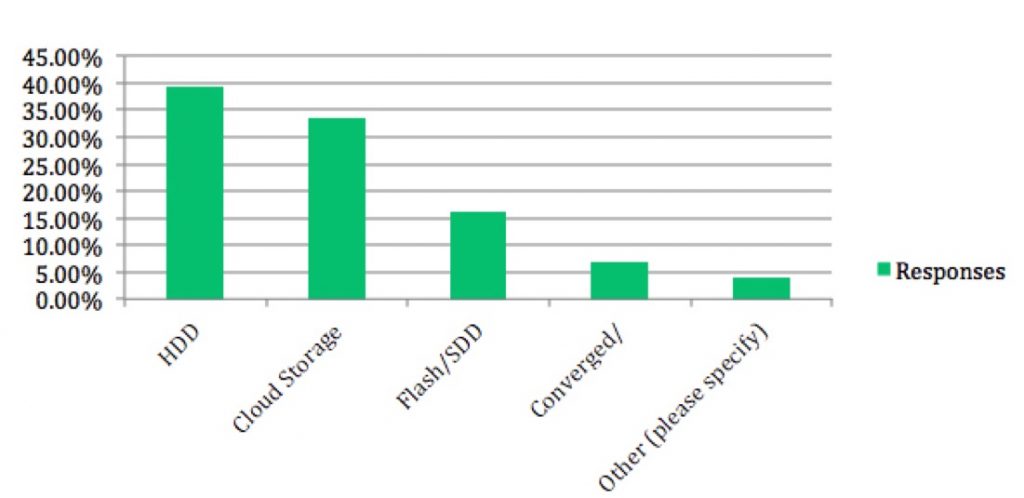Cloud Storage Takes Off, Flash Cools Off – Enterprise Storage Forum
Biggest storage budget line item is cloud storage, although HDDs still hold more data.
This is a Press Release edited by StorageNewsletter.com on August 27, 2018 at 2:40 pmThis article was posted on August 21, 2018, and was written by Mike Matchett.
Survey Results: Cloud Storage Takes Off, Flash Cools Off
The Enterprise Storage Forum survey results show that the biggest storage budget line item is cloud storage, although HDDs still hold more data. We explore why cloud is inevitably winning, and when the actual tipping point might come about.
Is on-premise storage dead? Is all storage inevitably moving to the cloud? If you work in IT these days, you are no doubt keeping a close eye on the massive changes afoot in storage infrastructure these days. Flash acceleration, hyperconvergence, cloud transformation – where is it all going and how soon will it get there?
We explored the past, present and future of enterprise storage technologies as part of our recent Storage Trends 2018 survey.
The Dominance of Cloud Storage
The short story is that cloud storage has now edged out the ubiquitous HDD as the top budget line item in IT storage spending (see below). We are not sure if this is good news or bad news for IT, but it is clear that those cloud-heavy IT shops have to get on top of and actively manage their cloud storage spending.
To which storage technology has your company allocated
the greatest amount of budget in the last 5 years?

Despite having cloud move into the lead for slightly more than 21% of companies, the game is not over yet for on-premise storage solutions. Flash has still not run it’s full course and HDDs are still the top budget item today for almost as many companies (21%) as cloud.
New innovations in solid-state like NVMe are providing even greater acceleration to data center workloads even as SDD prices continue to drop. As silicon price drops, total spending inherently skews towards more expensive technologies – the footprint will grow even if the relative spend doesn’t keep pace. And the higher relative costs of competing solutions could become a barrier to their growth. This also might account for some formerly cloud-centric companies with large data footprints moving back into private infrastructure.
Looking at the reported hosting of the largest data footprint (see below) with regards to major storage technologies, HDDs are still the number one primary storage platform for the largest group survey respondents. Cloud storage may be cheap and deep and garner a lot of secondary storage, but 65% still hold most of their primary data at home.
What storage technology hold the majority of your primary storage data?

The Media is the Message: Cloud Storage Will Grow Even Greater
There is no denying that we have a cloudy future. Cloud storage is still gaining ground with new applications and also itself takes advantage of silicon price drops. When we asked about particular storage technology purchasing plans (see Figure 3), cloud storage is the biggest future storage target landing in half of the survey respondents’ storage acquisition plans (50%). If we add up on-premise purchasing plans for HDD and SDD together we see just less than half (48% total).
Which storage technology (media) is your company seriously considering purchasing in the next 2 years? (check all that apply)

On many measures, cloud storage has not only reached parity with on-premise storage but now has exceeded it. Future adoption plans only show more cloud acceleration. Even as flash at 30% drives out HDD spending (at 18%), cloud easily outpaces flash. We don’t expect this market to tip 100% – you’ll notice tape still showing up in some of the above figures – but I’d bet on cloud.
Hip Hip Array: Software Defined Storage Moves Ahead
When we look at the types of arrays being considered for purchase (see below – defined here broadly and perhaps better called storage array types), we see that folks are starting to take their backup and DR plans a little more seriously. DR storage (likely deduplicating secondary storage) actually leads this comparison (24%) with NAS (16%) and SAN (21%).
In the bigger picture I’ve noticed that as more of the average business user’s productivity and effectiveness is based on IT hosted applications leveraged by increasing operational ‘data exploitation,’ that keeping those applications and data sets online extends data protection goals. IT needs to protect not just mission critical assets, but business productivity and operational analytical processing now too.
NAS and SAN arrays together (37%) also exceed software defined storage (SDS) (21%) plans, but we think there is so much ‘crossover’ with many modern versions of storage OSs now turning into software defined storage (SDS) that it’s hard to really draw a conclusion about hardware vs. software. What is interesting is that if we add SDS to Converged/Hyperconverged (38%) (HCI depends on SDS), we see as much intention to spend in that direction as to continue purchasing traditional SAN/NAS arrays.
Which storage technology (array type) is your company seriously considering purchasing in the next 2 years? (check all that apply)

Flash in the Clouds: A Hybrid Future
If there is one big takeaway from these insights it’s that cloud storage now has to be considered the heavyweight storage contender, even if there is a lot of legacy HDD footprint and on-premise primary storage. The future is probably a hybrid one (at least for a long time to come), but cloud is clearly going to grow faster in terms of both budget and (subscribed) capacity.
HDDs probably lose out in the long run in favor of off-site protected bulk cloud secondary storage backing up ever denser (i.e. more cost-effective) on-premise flash for primary storage. But we also expect increasing flash performance in the cloud to offer a bigger incentive to migrate more primary data and their workloads to the cloud as well. As clouds inexorably offer better and better performance, they can also offer a better price due to their inherent multi-tenancy efficiencies.
Given the two-year purchasing intention data, older technologies like HDDs, NAS and SANs aren’t going away as fast as some have predicted. In fact, given that most arrays are already hybrid (in media) and beginning to inherently tier to cloud storage (hybrid architecture), the industry may just shift the traditional definitions. But under the hood, expect much of our storage spend and footprint to move up and out of the data center into cloud storage.













 Subscribe to our free daily newsletter
Subscribe to our free daily newsletter

